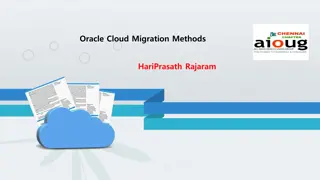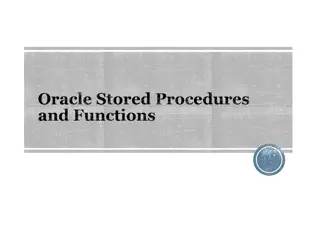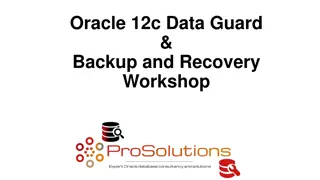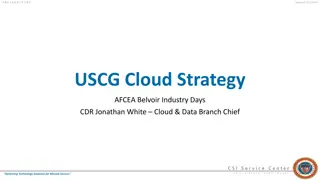Understanding Oracle Data Guard: A Comprehensive Overview
Explore the history, types, and configurations of Oracle Data Guard, including physical and logical standby databases, active data guard, and high availability options. Learn about the architecture, maintenance processes, and licensing requirements for implementing Data Guard in your Oracle environment.
Download Presentation

Please find below an Image/Link to download the presentation.
The content on the website is provided AS IS for your information and personal use only. It may not be sold, licensed, or shared on other websites without obtaining consent from the author. Download presentation by click this link. If you encounter any issues during the download, it is possible that the publisher has removed the file from their server.
E N D
Presentation Transcript
Oracle High Availability Options Oracle Data Guard Physical Standby Database Logical Standby Database Oracle Active Data Guard Read only Physical Standby Database Oracle Golden Gate Sort of Active Read/Write Logical Standby Database Oracle RAC HA option within Data Center
Standby Database Types Standby Database Types Physical standby database Logical standby database Oracle Active Data Guard(11g) Snapshot standby database (11g) Cascading standby database Far Sync Instance(12c) Heterogeneous DataGuard .
Physical Standby Database Data Guard configuration with ARCH transportation mode .
Physical Standby Database Exact, block for block copy of a primary database Maintained through a process called as Redo Apply Redo Received from Primary is continuously applied to a physical Standby database Can be opened for a read only access Redo Apply can still be active while Database is open Active Data Guard Additional License is required. .
Logical Standby Database Initially created as Identical copy of Physical database Can be altered to have different Structure at later stage It always remain OPEN . Maintained through a process called SQL APPLY Additional objects,schema s can be created apart from what is maintained by SQL APPLY. Tricky part is to protect the data set being maintained by Dataguard (SQL Apply).
Oracle Active Data Guard Oracle Active Data Guard - Oracle active data guard is an option for Oracle Database 11g Enterprise Editi on. Enhances Quality of Service by offloading resource-intensive activities from a production database to o ne or more synchronized standby databases. Oracle Active Data Guard enables read-only access to a physical standby database for queries, sorting, r eporting, web-based access, etc., while continuously applying changes received from the production datab ase. Oracle Active Data Guard also enables the use of fast incremental backups when offloading backups to a standby database, and can provide additional benefits of high availability and disaster protection against pla nned or unplanned outages at the production site. .
Snapshot Standby Database This is an Updatable Standby database Additional Feature over and above Physical Standby Database. Database is open for read write operations while Redo Apply is stopped. Still receives Redo data and store as Archive Log files. Uses Flashback and Guaranteed Restore Points to perform the action. Useful in for performing any testing when it cannot be done on Primary. Need to maintain FRA with adequate size depending on the load.
Cascading Standby Database cascading standby database is a standby database that receives its redo logs from another standby data base, not from the original primary database. The standby database, which serves the cascading standby d atabase, is created from the primary database using RMAN (active) duplication method or restored from a b ackup of the primary. The following image shows a primary database sending redo data over Oracle network to a physical stan dby database and a logical standby database. The physical standby database retransmits the redo data to another physical standby database (Cascading standby 1).The logical standby database generates the red o data into SQL statements, which are then transmitted to another physical standby database (Cascading st andby 2).
Far Sync Instance New in Oracle 12c Accepts Redo from Primary Database Send Redo to other Standby databases Contains Control Files and Standby Redo Logs Does Nothave Datafiles. Require very less disk and memory resources Preferred to be in same geographic location as of Primary Useful during the time of maintenance on Standby Site Require Additional License (Oracle Active Dataguard)























